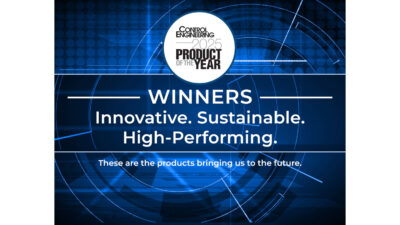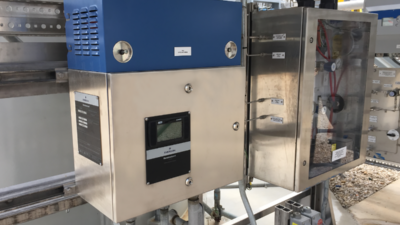Since the beginning of time, humans have used the most fundamental of all analyzers—their nose—to sniff the quality of air, food, or drink. Over the ages, great advances have refined the methods by which we analyze a given substance or product to determine its composition. Today, users have a wide variety of choices to analyze gases, liquids, and solids.
KEY WORDS
Process control & instrumentation
Instrumentation
Process analyzers
In-line analyzers
Since the beginning of time, humans have used the most fundamental of all analyzers-their nose-to sniff the quality of air, food, or drink. Over the ages, great advances have refined the methods by which we analyze a given substance or product to determine its composition. Today, users have a wide variety of choices to analyze gases, liquids, and solids. Each technology has advantages and disadvantages that must be weighed against the application for successful implementation.
Virtually all process analytical systems today originate from the laboratory environment. Users were often the first to try and reconfigure these laboratory instruments for direct on-line measurements. In situations where a laboratory instrument was incompatible with a process, users developed their own instrumentation to perform on-line analysis. In time, suppliers began to offer dedicated process analyzers based on their own designs or user-licensed technologies. Often, these early systems did not demonstrate robust design principles, were complex, and required frequent maintenance and oversight by highly trained technical personnel. This led to a poor reputation, often justified, for many process analytical techniques.
Concurrent demands to decrease manufacturing costs, improve product quality, and meet stringent health and safety requirements are leading many companies on a path toward greater use of process-analytical instruments. In today’s hyper-competitive global market where response to market requirements must often be instantaneous, sending process samples to a central lab for analysis, which can take from several hours to several days, is no longer acceptable. Staffing requirements for such laboratories to perform routine analysis is increasingly being considered an undue overhead expense. Companies seek innovative solutions to trim laboratory budgets, increase product yields, and comply with regulations. Suppliers of process analytical systems (PANS) claim they have the solutions to meet these diverse requirements. Technology advances have played a leading role in helping suppliers deliver such solutions.
The analytical instrumentation industry, however, has reached a state of maturity that can be defined by fewer technological leaps and a commoditization of instruments. Rather than revolutionary leaps in new analytical technologies, the future will see a more evolutionary advancement in analytical instrumentation. While maturity in the market is more strongly felt for laboratory instruments, similar trends can be seen for process analyzers as well. Process analyzers, however, have lagged behind their laboratory counterparts in the adoption of the latest technologies. Therefore, to have some idea what is in store for process analyzers, one needs to simply look at current laboratory offerings.
Advances in the lab
Within the past several years new technologies have been introduced to perform rapid laboratory gas chromatography (GC) analysis. Varian Corp. (Palo Alto, Calif.) offers a cryogenic focusing system for their GCs, which significantly reduces analysis time. Thermedics Corp. (Chelmsford, Mass.) takes a different approach by performing extremely rapid temperature cycling of the GC column to reduce analysis time. In both approaches, analysis of compounds has been significantly reduced from tens of minutes to only a couple of minutes. Applied Automation’s (Bartlesville, Okla.) newest GC, the Advance Maxum applies the laboratory technique of parallel chromatography to a process analyzer, greatly decreasing analysis time. Each demonstrates how laboratory techniques/technologies can move much closer to real-time GC analysis, providing the capability for much tighter process control.
Microelectronics is another field with numerous technologies that bear watching. One of the most interesting is the ‘lab-on-a-chip’ design concept. Using advanced nano-technology manufacturing techniques, borrowed from the semiconductor industry, researchers are developing extremely small postage stamp-size labs on a microchip. These ‘nanolabs’ are capable of performing very accurate, often complex chemical reactions and analysis rapidly with minimal chemical reagents. For example, researchers have performed complex liquid chemical separations in as little as 150 msec. With their small size, minimal use of reagents, and relative operational simplicity, it may soon be possible to reduce the size of a process wet chemistry analyzer from a cubic meter to several cubic centimeters, with only a few centiliters or milliliters of reactant consumed per year.
An interesting technology still under development is fiber-optic chemical sensors. Such sensors combine fiber-optic technology with a fluorescent chemical reaction at the distal tip to perform analysis. Current research centers on developing sensors to monitor gases and pH in liquid streams. The ability to combine several distinct chemical reactions with multiplexed fibers may lead to compact fiber bundles that can perform numerous precise dedicated measurements simultaneously in a process from a single entry point.
While basic physical and chemical principles by which process streams are analyzed has not changed, the enabling technology to perform these measurements is changing. Significant advances in material science, optics, electronics, computers, and software are all playing a role in the development of new PANS with increased sensitivity, robustness, and ease-of-use. These advances are also leading to the development of much more compact systems that are less expensive to house, have fewer consumables, and require less real estate within a plant.
IT makes its presence felt
Information technology (IT) is having the most significant impact on PANS. The microprocessor has made its presence felt in all PANS, from simple conductivity sensors to sophisticated, full scanning Fourier transform near infrared analyzers. Low-cost microprocessors are resulting in new sensor concepts. The Thorton Associates Inc. (Waltham, Mass.) conductivity sensor with an embedded microprocessor in the sensor itself to continuously store and update information on sensor properties, is one example. Manufacturers are also putting intelligence into their analyzers to perform numerous functions including PID control and system health monitoring. System health monitoring comprises sensor self-diagnostics and auto-calibration. Such features are significantly reducing instrument maintenance requirements.
Prior to the advent of inexpensive, high-speed microprocessors, analysis of spectral rich data, such as those produced by most spectroscopy-based systems, could not be performed rapidly enough for real-time monitoring of process applications. This is particularly true for near-infrared applications that use computationally intensive algorithms. Abiding by Moore’s Law, computer-processing power is doubling every 18 months while the price remains constant. Greater microprocessor power, combined with advanced software and new optics technology, is producing new spectroscopy systems with more rapid scanning capabilities.
Faster computers also enable resulted in the ability of software based on a graphical user interface (GUI) model. Rather than typing code, a GUI, which has become ubiquitous with most common desktop applications, allows the user to more readily navigate through a program to configure an instrument for an application. In addition to simplifying systems set-up, software simplifies analyzers for non-technical operators. Simple menu structures combined with automated prompting routines are allowing operators to easily monitor, calibrate and perform sophisticated analysis.
The exponential growth of the Internet and Internet-based technologies influences PANS. Internet impact is only beginning, but potential is enormous. Currently, several PANS suppliers provide customer services via the Internet. For example, suppliers are using the Internet to assist customers in developing applications for their PANS, in real-time, by remotely monitoring analyzer output and configuring the software accordingly. Several suppliers are also providing remote service support for their PANS via the Internet. Such support lowers supplier costs, while speeding user service.
Fisher-Rosemount (Austin, Tex.) has recently embedded web-server technology into its GCx. This allows the user to call-up the chromatograph, via an Internet browser from anywhere in the world to monitor the instrument’s performance and health.
Photonics revolution
Optical science research (photonics) is one of the most dynamic fields today, seeing enormous research and development investments from some of the largest companies in the world. While the vast majority of this research is dedicated to telecommunications and multimedia industries, the spillover of these technologies is significantly impacting development of PANS, especially spectroscopy-based instruments. Fiber-optic technology provides users ability to monitor several remote points in a process with a single analyzer. Detectors using charge-coupled device arrays are resulting in fully digital instruments with extremely rapid scan rates. Optical switches are eliminating mechanical choppers, which are prone to failure. Tunable diode lasers provide more coherent and compact light sources. The combined technologies deliver compact, fully digital analyzers. These analyzers have no moving parts, thereby increasing reliability. It is not a stretch of the imagination to foresee future photonics-based PANS that more closely resemble a common transmitter rather than the large analyzers of today.
Materials research also makes its presence felt via new solid-state detectors for analytical systems that improve detection limits and minimize detector cooling requirements. New attenuated total reflectance (ATR) optic probes for in-situ monitoring applications are capitalizing on materials research. ATR probes use advanced diamond films, which are both chemically inert and have excellent transmission properties.
Advances in microelectronics have compacted instrument sizes and virtually all forms of PANS benefit. For example, ABB, Fisher-Rosemount, Onix Systems (Kingwood, Tex.), and Yamatake Corp. (Tokyo, Japan) all offer compact gas chromatographs targeted at specific applications. Microelectronic surface-mount technology eases electronic board configuration for specific applications.
Modular, with fewer parts
General trends which most suppliers are supporting in the development of their systems can be grouped into four categories. First, suppliers are adopting a more modular approach to instrumentation design. Second, suppliers are moving customers toward a common user interface across product lines to minimize user-training requirements. Third, fewer parts in new process analytical systems decreases manufacturing costs, increases reliability, and minimizes service and spare-part requirements. And fourth, PANS are increasingly being developed for dedicated applications, simplifying their use.
The modular approach benefits suppliers and users. Suppliers can more readily build a common platform for systems across a product line. ABB’s Hartmann & Braun Div. (Wickcliffe, O.) applied the modular design concept to its new Advance Optima line of continuous gas analyzers. This resulted in an average order-of-magnitude decrease in parts from 5,000 pieces to 500 for these analyzers. Pursuing a modular design approach also allows the supplier to outsource key critical components that are prohibitively expensive to manufacture in-house and lowers total analyzer cost. Modularly designed PANS also lower user’s total cost of ownership by minimizing spare parts inventory and simplifying maintenance.
A dramatic decrease in plant staffing necessitates the need for PANS that are easier to operate and maintain. One way in which suppliers are attempting to meet this need is through development of standard user interfaces. When operator input is required, providing commonality of the human machine interface among various instruments, particularly through the use of GUIs, simplifies training requirements.
As the instruments move toward becoming commodities, suppliers will focus more on developing dedicated analyzers for specific applications in niche markets. No longer must a user place a high reliance on a Ph.D. chemist to configure and monitor a PANS’s performance Dedicated application-specific PANS greatly simplifies user set-up and operation.
As new competing technologies become available, users will face increasingly difficult choices in selecting the most appropriate technology for their applications. Identifying supplier partners who have demonstrated technical excellence can aid inprudent adoption of technologies. Such suppliers can assist in developing process optimization and monitoring strategies that combine the most advanced technologies with the most appropriate analytical technique.
Benefits of Technology Advances
From
To
Technology
Benefits
Large analyzers
Compact analyzers
Smaller housings, less space
Many mechanical parts
Fewer mechanical parts
Photonics, electronics, modular design concepts, software
More robust, higher MTBF
Manually intensive
Semi-autonomous systems
Lower maintenance
High analyzer drift
Low analyzer drift
Electronics and
Greater accuracy and precision
Sampling trains
In situ measurement
Advanced materials
Easier installation and high MTBF
Low precision and accuracy
High precision and accuracy
Solid-state detectors and
Improved analytical data
Complex software
Simpler, menudriven software
GUI software and
Less training
Source: Control Engineering with information from ARC Advisory Group
Author Information
John Moore is the director, field systems at ARC Advisory Group Inc. (Dedham, Mass.)



